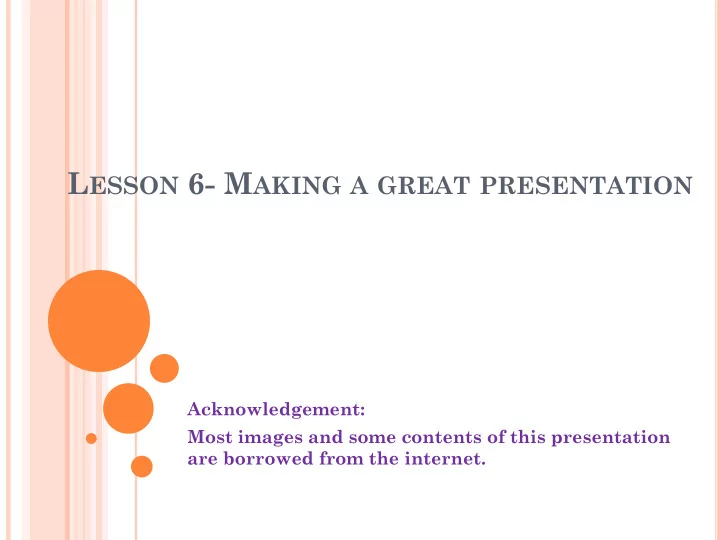

L ESSON 6- M AKING A GREAT PRESENTATION Acknowledgement: Most images and some contents of this presentation are borrowed from the internet.
H OW TO MAKE A GREAT PRESENTATION ? There are hundreds different ways to make a presentation. Some common essentials are: Clear objectives Well-defined logic Convincing facts/examples Closely connected with audience And, of course, much more …… body language, dress, emotion, action, sense of hummer, word choice, tone, etc.
S OME GREAT PRESENTATIONS AVAILABLE ONLINE Twenty must see TED talks for computer scientists www.youtube.com/playlist?list=PLF7032F8EB1A4 F9E2 Steve Jobs’ 2005 Stanford Commencement Address http://www.youtube.com/watch?v=UF8uR6Z6KLc
C LEAR OBJECTIVES What is the purpose(s) of your presentation? What do you try to accomplish through the presentation? Get your dream position? Explain a project to your boss, teammate, or general public to gain support from them? Knowledge sharing and public awareness? Make a sale? Motivate others ? Report your accomplishments? ……
P RESENTATION PREPARATION o Purpose: Why ? o Content: What ? o Place: Where ? o Delivery: How? o Audience: Who ? “ I want (who) to (do what) (where, when and how) because (why)”
C ONTENT SELECTION AND ORGANIZATION Choosing contents/material that Support your points Fits the audience Comes from a variety of sources Arrange points logically and sequentially Show reasons to accomplish your objective(s) If you are confused, you can’t make others understand! You certainly need to have an idea flowchart in your mind
C AREFULLY DESIGN THE BEGINNING o Provide a self-introduction o Get the audience’s attention - shock, humor, question, story, facts & figures - Should be well rehearsed yet natural o Motivate audience to listen - their needs, interests, benefits
V ISUAL AIDS AND HANDOUTS The audience came to SEE you for your presentation Your slides are visual aids only to ENHANCE the presentation, not BE the presentation Ensure clear visibility If you’re only going to read from the slides, then just send them the slides! Handouts help audience to recall
S TAGE PRESENCE Be confident and professional: overcome stage fright Be focused on your purpose: use controlled gestures Be direct and sensitive to the audience: eye contact, take non-verbal feedback, body language Be active and passionate: move around with vocal variations (pitch, volume, rate) Be willing to modify and adjust to meet audience needs Don’t just make it as a presentation but effective communication
H ANDLING QUESTIONS o Anticipate and keep answers ready o Sometimes questions themselves give you a lead to highlight your point of view o Do not get confused by questions but focus on the purpose and always be professional o It is alright to say “I do not know” or “I will look into it”. You are not supposed to know everything.
E THICS Your reasoning must be supported by facts from your own experience, experiments, or from reputable trustworthy sources Falsifying facts to reach ones own purpose can not only ruin ones reputation but also cause catastrophic damages to the society! Professional ethics is extremely important for success!
P RESENTATION PITFALLS o Disorganized material o Lost control o Time mismanagement o Speaking too fast o Using jargon o Tone and content o Complicated or ambiguous language o Not questioning o Negative comments o Without summary at the closing to highlight important points o …
A SSIGNMENTS AND EVALUATION Choose a topic on current advances in CS/IT and prepare a 10 minute in-class presentation Your presentation will be evaluated according to the rubrics
E XPECTED OUTCOMES Outcome f. An ability to communicate effectively with a range of audiences; Outcome g. An ability to analyze the local and global impact of computing on individuals, organizations and society; and Outcome h. Recognition of the need for, and an ability to engage in, continuing professional development.
I NDICATORS FOR OUTCOME F Outcome f. An ability to communicate effectively with a range of audiences; The effectiveness of your presentations are measured by the following indicators: Contents organization (clear purpose, main ideas are supported with examples and stories) Verbal and non-verbal skills (including stage presence) Peer evaluation
I NDICATORS FOR OUTCOME G Outcome g. An ability to analyze the local and global impact of computing on individuals , organizations and society This ability should be demonstrated in the presentation of your self-selected topic on new development in CS and IT
I NDICATORS FOR OUTCOME H Outcome h. Recognition of the need for, and an ability to engage in, continuing professional development. The ability is measured with: Recentness of the topic Broadness of references used
R UBRICS AND PEER EVALUATION low average high 1 2 3 4 5 1. Relevance and currency of subject 1 2 3 4 5 2. Purpose, main idea, and summary 1 2 3 4 5 3. Possible impacts on individual, organization and society 1 2 3 4 5 4. Contents organization 5. Verbal skills 1 2 3 4 5 6. Non-verbal skills 1 2 3 4 5 Overall rating: 1 2 3 4 5
Recommend
More recommend